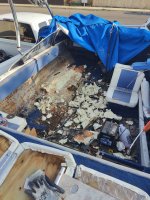Well, it is time to start the tear down of my old Bayliner. Thank you everyone who gave me advice in my earlier thread.
Pulled the engine and transom assembly off today. I was definitely over optimistic about the transom being good. Now the first question I have is how thick should the wood be made for the new transom? The hull appears to be 3/8" thick, and I know I need between 2" to 2-1/4" total thickness. I just am not sure how much thickness the glassing will add.
Tomorrow I will start ripping the decking out of the boat and stripping the old wood from the transom.
This is probably going to be a slow process once I begin all the build up. I figure I only have about two months of being able to fiberglass before the temps get too low. After that I will have to wait until next year.
Also, only for the transom, I may end up going with Coosa board. I'll use plywood for everything else.
Pulled the engine and transom assembly off today. I was definitely over optimistic about the transom being good. Now the first question I have is how thick should the wood be made for the new transom? The hull appears to be 3/8" thick, and I know I need between 2" to 2-1/4" total thickness. I just am not sure how much thickness the glassing will add.
Tomorrow I will start ripping the decking out of the boat and stripping the old wood from the transom.
This is probably going to be a slow process once I begin all the build up. I figure I only have about two months of being able to fiberglass before the temps get too low. After that I will have to wait until next year.
Also, only for the transom, I may end up going with Coosa board. I'll use plywood for everything else.






















